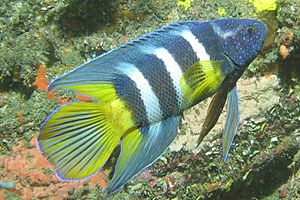Eastern blue devil facts for kids
Quick facts for kids Eastern blue devil |
|
|---|---|
 |
|
| Scientific classification | |
| Synonyms | |
|
The Paraplesiops bleekeri, also known as the eastern blue devil or Bleeker's blue devil fish, is a super colorful and a bit shy fish. It belongs to a family of fish called Plesiopidae. This amazing creature lives only in Australia and is a protected species, which means it's really important to keep it safe!
Contents
What Does It Look Like?
This fish can grow up to 40 centimeters long. That's about the length of your forearm! It's easy to spot with its bright blue and white stripes on its body. It also has cool blue spots on its head. Its fins on its back and belly are blue too. Other fins, like the ones near its chest and tail, are yellow. Some of its fins are extra long and flowy!
The eastern blue devil fish has a close relative. It's called the southern blue devil (Paraplesiops meleagris). This cousin lives in the colder waters of southern Australia.
Where Does It Live?
You can find the eastern blue devil fish along the eastern coast of Australia. They live in the ocean waters from the Gold Coast in southern Queensland. Their home stretches all the way down to Montague Island. They are most often seen around Sydney and Ulladulla.
How Does It Behave?
These fish are quite shy and like to keep to themselves. They are most active when it's dark, at night. Male eastern blue devils seem to protect their special spots. These spots are usually caves or overhangs in the reef. They stay there to attract female fish and to chase away other males.
Where Is Its Home?
Eastern blue devil fish live on coastal reefs. They make their homes inside caves, under ledges, and beneath overhangs. You can find them in reefs and even in estuaries, which are where rivers meet the sea.
They were thought to live in waters from 3 to 30 meters deep. They are most often found in shallow waters less than 20 meters deep. However, people have recently seen them in deeper offshore reefs. They can live down to at least 50 meters deep!
What Does It Eat?
This fish is known to eat brittle stars. Brittle stars are small sea creatures that look a bit like starfish.
Why Is It Protected?
The eastern blue devil fish is a protected species. This means it's against the law to catch or own them without a special permit. This rule is part of the Fisheries Management Act 1994 in New South Wales.
They are protected for a few reasons. There aren't many of them in the wild. Also, many people want them for marine aquariums. This makes them very desirable.
To help protect them, people are working to save their homes. This includes their reef habitats and rocky offshore areas where they breed. Some of the protected places where they live are:
- Solitary Islands Marine Park
- Port Stephens – Great Lakes Marine Park
- Jervis Bay Marine Park
- Long Reef Aquatic Reserve
- Bushrangers Bay Aquatic Reserve
How Did It Get Its Name?
The specific name of this fish, bleekeri, honors a Dutch scientist. His name was Pieter Bleeker (1819-1878). He was a doctor and studied fish. He had named two similar types of fish before this one.
See also
 In Spanish: Paraplesiops bleekeri para niños
In Spanish: Paraplesiops bleekeri para niños

